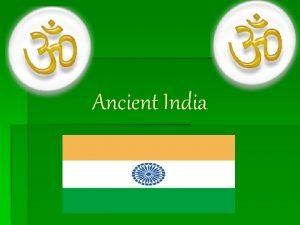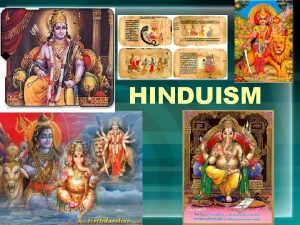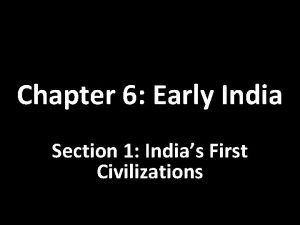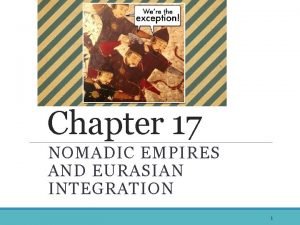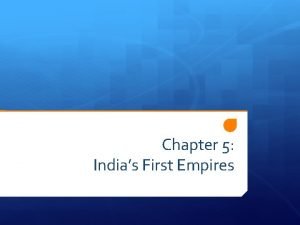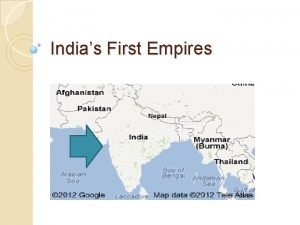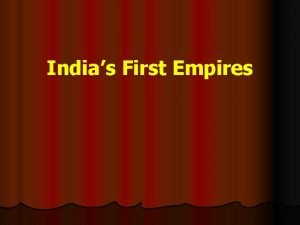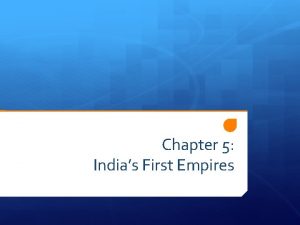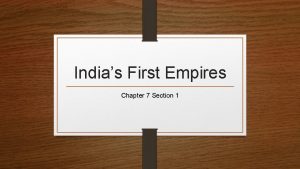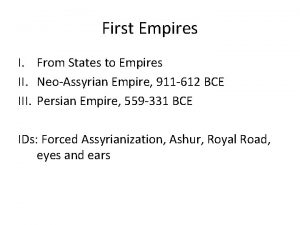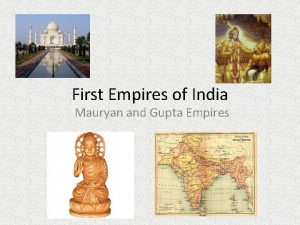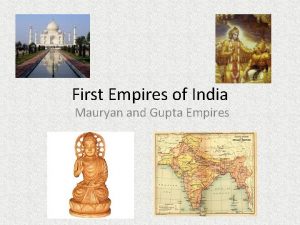Indias First Empires Ch 7 Sec 1 A

















- Slides: 17

India’s First Empires Ch 7 Sec 1

A cyborg dragonfly! Government means of surveillance continue to get more and more advanced – you’ve been bugged!

Chandragupta Maurya • First ruler of the Mauryan Empire (321 B. C. ). – Overthrew an unpopular king (The Nanda of Magadha) to become ruler. – Conquered much of Northern India, from the Ganges river to the Indus River, over 2, 000 miles (see map). Fun Facts: C. M. feared being assassinated (perhaps b/c he killed the last king) so to void being poisoned he had official food tasters taste all his meals. TO avoid being murdered in bed he slept in a different room every night and had an armed guard of women which surrounded him at all times and killed anyone who came inside the “protected circle. ” Q: Why women guards?

Mauryan Empire • First Empire of India to unite most of the subcontinent (except the Tamil States in extreme south) • 321 B. C. – 232 B. C.

Kautilya • Royal advisor & Hindu Priest (Brahmin) who advised Chandragupta Maurya and wrote a political guidebook called the Arthasastra.

Arthasastra • A book – to advise Mauryan rulers on how to rule (written by Kautilya). • Advocated that the king test his subjects by creating a spy network of informers.

Tamil People • Matriarchal – lived in Southern India – never conquered by Mauryan or Gupta empires.

Matriarchal • Social hierarchy follows the female line. Property & power is traced through the female line. • Matriarch = Mom in charge

Asoka • Mauryan Ruler who brought the empire to its greatest height (ruled from 272 -232 B. C. ). • Won the Battle at Kalinga but converted to Buddhism afterward (due to the carnage). • Instituted a policy of toleration of all faiths.

Add: Religious Toleration • Acceptance of people who hold different religious beliefs.

Gupta Empire • Started by Chandra Gupta I in 320 A. D. (He married into the throne and took the name “Great King of Kings. ” • Expanded the Empire through political alliances & conquest. • The Gupta period 320 – 535 A. D. is considered a Golden Age of Indian culture & achievements.

Chandra Gupta II • Ruled the Gupta Empire from 375 -415 A. D. during its Golden Age. • Honored as a Great King due to his heroic qualities – winning many battles. – Lion Hunt Coins / Conquered trading cities = $$ • Also expanded the Empire through diplomacy and marriage alliances. • Diplomacy? = • Negotiation / talk between countries.

3. Why was Asoka’s first military campaign also his last campaign? • The battle was so horrible – the deaths of 100, 000 s that Asoka became peaceful. • After the Battle of Kalinga, Asoka became a Buddhist and stopped waging war. • It is said that the battle of Kalinga was so bloody that he swore to never be the cause of such violence again.

4. Who were the Tamil People? • The Tamil people lived on the Southern tip of the Indian subcontinent. – Never conquered by the Mauryan or Gupta Empires in the North. – Some Tamil groups were Matriarchal – where family property and the right to rule was passed down through the female line.

5. What caused the fall of the Gupta Empire? • The Empire was invaded by the Hunas (Huns) in the 5 th Century. • Internal division broke the empire apart into small kingdoms. • Lacking a strong central government the smaller kingdoms were overrun by the Huns. • The Gupta Empire fell for good in 535 A. D.

6. Which Indian ruler would you rather have lived under and why? • Answers need to be supported with evidence. • Possible Example: “If I lived during the time of the Mauryan Empire I would rather have lived under Asoka. I think this because after he converted to Buddhism, he instituted a policy of religious tolerance and since I am not Hindu or Buddhist this seems to be a good time to be living in India. ”

7. What was the impact of the Greeks, Persians, and Central Asians on Indian life? The Greeks, Persians, and Central Asians (Huns) conquered (invaded) Indian lands during the time between the Mauryan and Gupta Empires. These invasions caused cultural disruptions (cultural diffusion) which influenced Indian life in both positive and negative ways. Positive: New Ideas like medical breakthroughs (plastic surgery developed) Negative: Death and destruction, human rights abuses due to the many wars and political turmoil. Why it matters now: Peace is ONLY POSSIBLE THROUGH STRENGTH! (Asoka’s tolerant empire was only possible b/c all rivals were already destroyed!)
 Maritime based empires a comparison chart
Maritime based empires a comparison chart Indias first civilization
Indias first civilization The maurya and gupta empires
The maurya and gupta empires Indias first empire
Indias first empire Indias religions
Indias religions Sociedad colonial americana
Sociedad colonial americana Indias major religion
Indias major religion Flota de indias ruta
Flota de indias ruta Indias religions
Indias religions Cast system in india
Cast system in india Chapter 7 section 1 india's first empires
Chapter 7 section 1 india's first empires First age of empires
First age of empires Chapter 7 section 1 india's first empires
Chapter 7 section 1 india's first empires Online trading demo
Online trading demo India empires
India empires Tamerlame
Tamerlame Four empires of mesopotamia
Four empires of mesopotamia Nomadic empires and eurasian integration
Nomadic empires and eurasian integration



